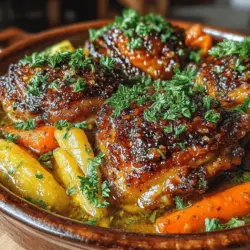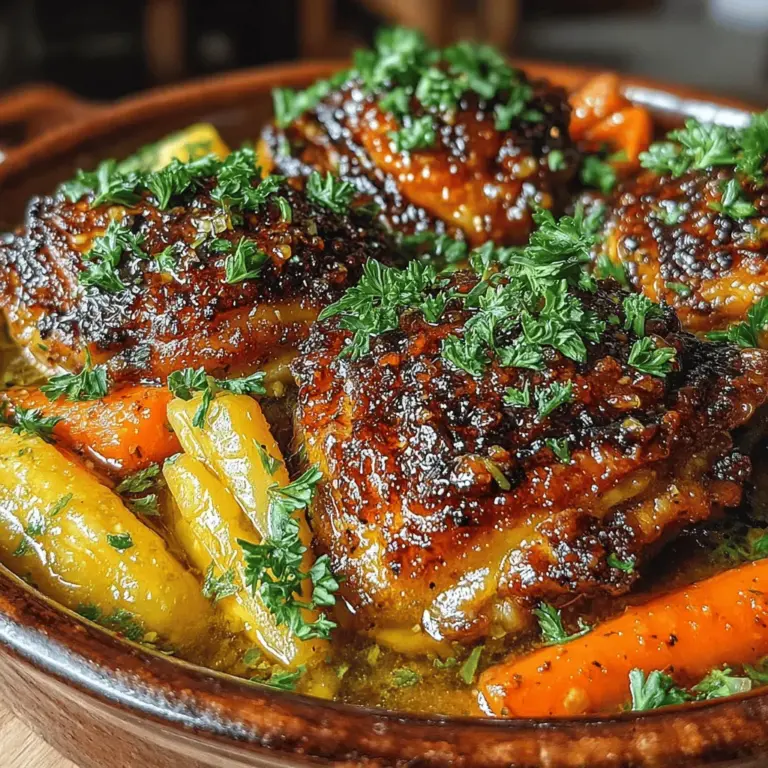Introduction to Honey Roasted Chicken & Carrots
In the realm of comforting meals, few dishes can compete with the delightful combination of honey roasted chicken and carrots. This harmonious recipe stands out not only for its pleasing aesthetics and enticing aroma but also for its ability to bring together succulent chicken thighs and sweet, caramelized carrots. Infused with a savory marinade, this dish elevates the flavors to new heights, making it a go-to choice for family dinners, casual gatherings, or any occasion that calls for a meal that feels like a warm hug.
The beauty of honey roasted chicken and carrots lies in its simplicity and versatility. Whether you are an experienced cook or a novice in the kitchen, this recipe is designed to guide you through each step, ensuring that you can achieve perfection with ease. The combination of sweet honey, savory soy sauce, and fresh herbs delivers a layered flavor profile that is as satisfying to prepare as it is to eat. As we delve deeper into this recipe, we will explore its origins, the nutritional benefits of its ingredients, and provide you with a detailed step-by-step process to create this mouthwatering meal.
Understanding the Ingredients
Before diving into the cooking process, it is crucial to understand the ingredients that make this dish shine. From the choice of chicken to the role of fresh herbs, each component plays a significant part in the overall flavor and nutritional profile of honey roasted chicken and carrots.
Exploring Chicken Thighs
When it comes to selecting the perfect cut of chicken for this recipe, bone-in, skin-on chicken thighs are a top choice. Unlike chicken breasts, which can dry out easily during cooking, chicken thighs are known for their rich flavor and inherent moisture. The skin, when roasted, becomes beautifully crisp while locking in the juices of the meat, ensuring that each bite is tender and satisfying.
Moreover, chicken thighs are often more economical than other cuts, making them an accessible option for feeding families or larger groups. Their higher fat content contributes to a depth of flavor that enhances the overall dish, allowing the sweetness of the honey and the earthiness of the carrots to shine through.
The Role of Carrots
Carrots are not just a side vegetable; they are a key player in this recipe. Packed with vitamins A, C, and K, as well as antioxidants, carrots offer numerous health benefits. Their natural sweetness is accentuated through the roasting process, where the sugars in the vegetable caramelize, creating a rich, flavorful companion to the chicken.
The vibrant color of carrots adds a visual appeal to the dish, making it not only delicious but also beautiful on the table. Roasting them alongside the chicken allows them to absorb some of the savory flavors from the marinade, creating a cohesive dish that is both nutritious and satisfying.
The Magic of Honey
Honey is the star sweetener in this recipe, playing a crucial role in balancing the overall flavors. Its natural sweetness complements the savory elements of the dish, creating a harmonious blend that is irresistible. Unlike refined sugars, honey offers additional health benefits, including antioxidant properties and a lower glycemic index, which can help in managing blood sugar levels.
When mixed with other ingredients in the marinade, honey not only adds sweetness but also helps to create a beautiful glaze on the chicken and carrots during roasting. This caramelization process enhances the flavor profile, resulting in a dish that is both sweet and savory.
Soy Sauce and Its Umami Influence
Soy sauce is another essential ingredient in the marinade, contributing a rich umami flavor that deepens the overall taste of the dish. Understanding the flavor profile of soy sauce is important, as it adds a salty, savory element that balances the sweetness of honey and the earthiness of carrots.
When used in marinades, soy sauce enhances depth and complexity, penetrating the meat and infusing it with flavor. This combination of sweet and salty notes creates a delightful contrast that makes honey roasted chicken and carrots a standout dish.
Fresh Herbs in Cooking
Fresh herbs, particularly thyme and rosemary, play a significant role in this recipe. Their aromatic qualities not only elevate the flavor of the chicken and carrots but also bring a freshness that balances the richness of the other ingredients. Thyme has a subtle earthiness, while rosemary adds a fragrant, piney note, making them the perfect companions to the honey and soy sauce.
Using fresh herbs is ideal, but if they are not available, dried herbs can be substituted. However, it’s important to remember that dried herbs are more concentrated, and adjustments in quantity may be necessary to achieve the desired flavor.
Step-by-Step Preparation Guide
Now that we have a solid understanding of the ingredients, it’s time to move on to the preparation of this delicious dish. A successful cooking experience begins with proper preparation, and one of the first steps is to preheat your oven.
Prepping for Success: Preheating the Oven
Preheating the oven is a crucial step in achieving that perfectly crispy skin on the chicken. The ideal temperature for roasting chicken and carrots is typically between 400°F and 425°F. This high heat allows for the Maillard reaction to occur, creating a beautifully browned exterior while ensuring that the inside remains juicy and tender.
Make sure your oven is fully preheated before placing the dish inside, as this will ensure even cooking and optimal results.
Crafting the Perfect Marinade
The marinade is where the magic happens, blending all the flavors together for a truly delightful dish. To create the perfect marinade, start by whisking together the honey, soy sauce, minced garlic, and a splash of olive oil in a mixing bowl. This combination will form a sticky yet smooth mixture that coats the chicken thighs beautifully.
For those who enjoy experimenting with flavors, consider adjusting the marinade to suit personal preferences. Adding a splash of apple cider vinegar can introduce a hint of acidity, while a pinch of red pepper flakes can provide a touch of heat. Taste the marinade before adding the chicken to ensure it meets your desired flavor profile.
Marinating the Chicken
Once the marinade is ready, it’s time to marinate the chicken thighs. Place the chicken in a resealable plastic bag or a shallow dish, and pour the marinade over the top. Ensure that each piece is thoroughly coated, allowing the flavors to penetrate the meat.
For optimal results, marinate the chicken for at least 30 minutes to an hour at room temperature, or longer in the refrigerator if time allows. This will allow the flavors to meld and develop more depth. If you are short on time, even a quick 15-minute marinade can still impart some delicious flavor.
As the chicken marinates, you can prepare the carrots by peeling and cutting them into uniform pieces to ensure even cooking. This step is essential as it helps to promote even caramelization, allowing the carrots to roast beautifully alongside the chicken.
With the chicken marinating and the carrots prepped, you are well on your way to creating a dish that is sure to impress. The next steps will involve combining these elements and roasting them to perfection, resulting in a meal that is both exquisite and comforting. Stay tuned as we continue to explore the remaining steps in the creation of this delightful honey roasted chicken and carrots recipe.
{{image_2}}
Best Practices for Marinating Chicken: Timing and Storage
Marinating chicken is a crucial step in creating a dish that bursts with flavor. The timing of your marinade significantly affects the depth of flavor achieved. For optimal results, it’s best to marinate the chicken for at least 2 hours, but if time allows, aim for 4 to 8 hours. This duration gives the marinade ample time to penetrate the meat, enhancing both flavor and tenderness. If you’re planning to marinate overnight, ensure that the chicken is stored in the refrigerator to prevent any bacterial growth.
When marinating, use a non-reactive container such as glass or food-grade plastic. Avoid metal containers, as they can react with acidic ingredients, altering the flavor of your chicken. If you’re short on time, even a 30-minute marinade can add a noticeable flavor boost, but the longer you can let it sit, the better the results.
The Science Behind Marination and Flavor Penetration
Understanding the science behind marination helps appreciate why the timing and method are vital. Marinades typically consist of an acid (like vinegar or citrus juice), oil, and seasonings. The acid helps to break down protein structures in the chicken, allowing the flavors to penetrate more deeply. This process not only infuses the chicken with flavor but also contributes to its tenderness.
The oil acts as a carrier for the flavors while also helping to keep the meat moist during cooking. Seasonings, which can include herbs, spices, and sweeteners like honey, enhance the overall taste profile. The combination of these elements creates a harmonious blend that transforms your chicken into a delectable centerpiece.
Preparing the Carrots for Roasting
Techniques for Cutting Carrots to Ensure Even Cooking
Carrots are a natural companion to roasted chicken, both in flavor and nutrition. To ensure even cooking, uniformity in cutting is essential. Start by peeling the carrots, then slice them into even-sized pieces—about 1-inch thick is ideal. This size ensures that they cook through without becoming mushy. You can opt for traditional rounds or cut them into sticks or diagonal pieces for a different presentation.
If you’re using baby carrots, they can be left whole, but it’s wise to cut larger ones in half lengthwise to promote even roasting. The goal is to create similar cooking times for the chicken and carrots, ensuring a perfectly roasted dish.
Seasoning Tips for Enhancing the Natural Flavor of Carrots
While carrots have their own natural sweetness, enhancing their flavor with thoughtful seasoning will make them shine. Before roasting, toss the cut carrots in a drizzle of olive oil, salt, and pepper. For added depth, consider incorporating herbs like thyme or rosemary, which pair beautifully with both carrots and chicken. A touch of honey can also amplify the natural sweetness of the carrots, creating a delightful contrast with the savory chicken.
Additionally, spices like paprika or cumin can introduce a warm, aromatic element to your dish. The key is to balance the flavors so that the carrots complement the honey-roasted chicken without overwhelming it.
Assembling Your Dish
How to Effectively Layer the Chicken and Carrots in the Baking Dish
Once your chicken is marinated and your carrots are prepped, it’s time to assemble your dish. Start by preheating your oven to 400°F (200°C). In a large baking dish, arrange the marinated chicken pieces first, ensuring they have enough space between them to allow for even cooking. Next, add the seasoned carrots around and under the chicken. This layering technique ensures that the flavors meld together, with the juices from the chicken enhancing the carrots as they roast.
For optimal caramelization, avoid overcrowding the pan. If necessary, use two dishes to give both the chicken and carrots enough room to brown beautifully. Pour any leftover marinade over the top to infuse even more flavor as everything cooks.
Importance of Utilizing Leftover Marinade for Flavor Depth
Utilizing the leftover marinade can add an extra layer of flavor to your dish. As the chicken roasts, the marinade will caramelize, creating a delicious glaze that enhances both the chicken and the carrots. However, it’s crucial to ensure that any marinade that has come into contact with raw chicken is cooked to a safe temperature. For safety, consider simmering leftover marinade on the stove before adding it to the dish. This step ensures that any bacteria present is eliminated, allowing you to enjoy the rich flavors without worry.
Roasting Process
Ideal Roasting Times and Temperatures for Chicken and Carrots
To achieve perfectly roasted honey chicken and carrots, maintaining the correct temperature and timing is key. Roast your dish in the preheated oven at 400°F (200°C) for about 40 to 50 minutes. Chicken thighs typically take longer than breasts, so if you’re using a mix, be sure to check for doneness. The internal temperature of the chicken should reach 165°F (75°C) for safe consumption.
The carrots should be tender and slightly caramelized by the end of the roasting process. You can test their doneness by piercing them with a fork; they should be easily penetrable but still firm. If the chicken is done but the carrots need more time, you can simply remove the chicken and allow the carrots to roast a bit longer.
Recognizing Signs of Doneness for Both Chicken and Vegetables
Understanding the signs of doneness will help you serve a perfectly cooked meal. For the chicken, look for a golden brown skin that is crisp and an internal temperature of 165°F. The juices should run clear when pierced near the bone. For the carrots, they should be tender when pierced and have a slight caramelized edge.
If you notice that the chicken is browning too quickly, you can cover it loosely with aluminum foil to prevent burning while the inside continues to cook. Keep an eye on your dish towards the end of the cooking time, as every oven can vary slightly in temperature.
The Art of Basting
Explanation of the Basting Process and Its Benefits
Basting is a technique that involves spooning or brushing the pan juices over the chicken during roasting. This process helps keep the meat moist and enhances the flavor, resulting in a more succulent dish. It also encourages a beautiful, glossy finish on the chicken skin.
When to Baste and How to Do It Correctly
For optimal results, baste the chicken halfway through the cooking process, roughly 20 to 25 minutes in. Carefully remove the pan from the oven and use a ladle or spoon to scoop up the juices at the bottom, drizzling them over the chicken. Be cautious not to burn yourself, as the pan will be hot. Return the dish to the oven promptly to maintain the cooking temperature.
If you’d like, you can also add a little more honey during the basting process to create a richer glaze. This technique not only enhances the flavor but also contributes to a beautiful caramelization on the surface of the chicken.
Garnishing for Presentation
The Role of Parsley in Enhancing Visual Appeal
Once your honey roasted chicken and carrots are ready, garnishing is the final step that elevates the dish. Fresh parsley adds a pop of color and freshness that contrasts beautifully with the sweet caramel tones of the roasted chicken and carrots. Simply chop some fresh parsley and sprinkle it over the dish before serving. This small addition enhances the visual appeal and adds a fresh flavor that complements the meal.
Suggestions for Serving Alongside Complementary Side Dishes
When it comes to serving your honey roasted chicken and carrots, consider pairing them with side dishes that complement the flavors. A light salad with mixed greens, cucumber, and a citrus vinaigrette balances the richness of the chicken. Alternatively, fluffy quinoa or wild rice can absorb the delicious juices from the chicken, creating a satisfying and wholesome meal.
For a more substantial side, roasted potatoes or a creamy potato mash can provide a comforting element to your dinner. The key is to choose sides that will enhance the overall dining experience without overshadowing the star of the show—the honey roasted chicken.
Nutritional Information
Balanced Meal Components
This honey roasted chicken and carrots recipe not only delights the palate but also offers a balanced meal. Each serving typically contains around 350-450 calories, depending on portion sizes. The chicken provides a generous source of protein, while the carrots contribute essential vitamins and minerals, such as Vitamin A and potassium.
The healthy fats from the olive oil and honey contribute to overall well-being, making this dish a great choice for a nutritious dinner. Additionally, the combination of protein, healthy fats, and carbohydrates ensures that you feel satisfied and energized after your meal.
Dietary Considerations
For those with dietary restrictions, this recipe can be easily adapted. To make it gluten-free, simply ensure that all marinades and condiments used are labeled gluten-free. For a low-sodium version, reduce the salt in the marinade and focus on herbs and spices for flavor enhancement.
If you’re looking for a lower-calorie option, consider using skinless chicken breast instead of thighs. The cooking method remains the same, and you’ll still achieve a deliciously roasted dish. Additionally, experimenting with various vegetables can introduce new flavors and nutrients to the meal, catering to different dietary needs.
Conclusion: The Joy of Cooking Honey Roasted Chicken & Carrots
The recipe for honey roasted chicken and carrots is more than just a meal; it’s an experience that brings warmth and satisfaction to the dinner table. By understanding the ingredients, following the step-by-step preparation, and appreciating the nutritional benefits, anyone can master this delicious dish. As you enjoy the sweet and savory flavors, you’ll find that this recipe not only nourishes the body but also creates memories around shared meals with loved ones.
Embrace the joy of cooking and let this delightful dish become a staple in your culinary repertoire. Whether you’re hosting a family dinner or enjoying a quiet evening at home, honey roasted chicken and carrots promise to deliver comfort and joy in every bite.


